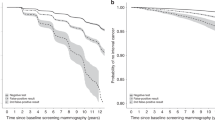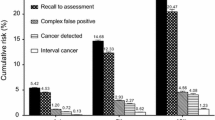Abstract
False-positive results may influence adherence to mammography screening. The effectiveness of breast cancer screening is closely related to adequate adherence among the target population. The objective of this study was to evaluate how false-positives and women’s characteristics affect the likelihood of reattendance at routine breast cancer screening in a sequence of routine screening invitations. We performed a retrospective cohort study of 1,371,218 women aged 45–69 years, eligible for the next routine screening, who underwent 4,545,346 screening mammograms from 1990 to 2006. We estimated the likelihood of attendance at seven sequential screening mammograms. Multilevel discrete time hazard models were used to estimate the effect of false-positive results on reattendance, and the odds ratios (OR) of non-attendance for the women’s personal characteristics studied. The overall reattendance rate at the second screening was 81.7% while at the seventh screening was 95.6%. At the second screening invitation reattendance among women with and without a false-positive mammogram was 79.3 vs. 85.3%, respectively. At the fourth and seventh screenings, these percentages were 86.3 vs. 89.9% and 94.6 vs. 96.0%, respectively. The study variables associated with a higher risk of failing to participate in subsequent screenings were oldest age (OR = 8.48; 95% CI: 8.31–8.65), not attending their first screening invitation (OR = 1.12; 95% CI: 1.11–1.14), and previous invasive procedures (OR = 1.09; 95% CI: 1.07–1.10). The risk of non-attendance was lower in women with a familial history of breast cancer (OR = 0.97; 95% CI: 0.96–0.99), and those using hormone replacement therapy (OR = 0.96; 95% CI: 0.94–0.97). In conclusion, reattendance was lower in women with false-positive mammograms than in those with negative results, although this difference decreased with the number of completed screening participations, suggesting that abnormal results in earlier screenings more strongly influence behavior. These findings may be useful in providing women with accurate information and in improving the effectiveness of screening programs.




Similar content being viewed by others
References
Brett J, Bankhead C, Henderson B, Watson E, Austoker J (2005) The psychological impact of mammographic screening. A systematic review. Psychooncology 14:917–938
Lerman C, Trock B, Rimer BK, Boyce A, Jepson C, Engstrom PF (1991) Psychological and behavioral implications of abnormal mammograms. Ann Intern Med 114:657–661
Bull AR, Campbell MJ (1991) Assessment of the psychological impact of a breast screening programme. Br J Radiol 64:510–515
Brewer NT, Salz T, Lillie SE (2007) Systematic review: the long-term effects of false-positive mammograms. Ann Intern Med 146:502–510
Salz T, Defrank JT, Brewer NT (2011) False positive mammograms in Europe: do they affect reattendance? Breast Cancer Res Treat 127:229–230
Day NE, Williams DR, Khaw KT (1989) Breast cancer screening programmes: the development of a monitoring and evaluation system. Br J Cancer 59:954–958
Chiarelli AM, Moravan V, Halapy E, Majpruz V, Mai V, Tatla RK (2003) False-positive result and reattendance in the Ontario Breast Screening Program. J Med Screen 10:129–133
Hofvind S, Wang H, Thoresen S (2003) The Norwegian Breast Cancer Screening Program: re-attendance related to the women’s experiences, intentions and previous screening result. Cancer Causes Control 14:391–398
Johnson MM, Hislop TG, Kan L, Coldman AJ, Lai A (1996) Compliance with the screening mammography program of British Columbia: will she return? Can J Public Health 87:176–180
McCann J, Stockton D, Godward S (2002) Impact of false-positive mammography on subsequent screening attendance and risk of cancer. Breast Cancer Res 4:R11
Brett J, Austoker J (2001) Women who are recalled for further investigation for breast screening: psychological consequences 3 years after recall and factors affecting re-attendance. J Public Health Med 23:292–300
Lampic C, Thurfjell E, Sjoden PO (2003) The influence of a false-positive mammogram on a woman’s subsequent behaviour for detecting breast cancer. Eur J Cancer 39:1730–1737
O’Sullivan I, Sutton S, Dixon S, Perry N (2001) False positive results do not have a negative effect on reattendance for subsequent breast screening. J Med Screen 8:145–148
Pinckney RG, Geller BM, Burman M, Littenberg B (2003) Effect of false-positive mammograms on return for subsequent screening mammography. Am J Med 114:120–125
Lipkus IM, Halabi S, Strigo TS, Rimer BK (2000) The impact of abnormal mammograms on psychosocial outcomes and subsequent screening. Psychooncology 9:402–410
Burman ML, Taplin SH, Herta DF, Elmore JG (1999) Effect of false-positive mammograms on interval breast cancer screening in a health maintenance organization. Ann Intern Med 131:1–6
Perry N, Broeders M, de Wolf C, Törnberg S, Holland R, von Karsa L (2006) European guidelines for quality assurance in breast cancer screening and diagnosis. Office for Official Publications of the European Communities, Luxenburg
Bulliard JL, De Landtsheer JP, Levi F (2004) Reattendance in the Swiss mammography screening pilot programme. J Med Screen 11:59–64
Assembly of Members (2001) CONSTITUTION AND BYLAWS of the European Breast Cancer Network
Roman R, Sala M, Salas D, Ascunce N, Zubizarreta R, Castells X (2011) Effect of protocol-related variables and women’s characteristics on the cumulative false-positive risk in breast cancer screening. Ann Oncol. doi:10.1093/annonc/mdr032
Ascunce N, Salas D, Zubizarreta R, Almazan R, Ibanez J, Ederra M (2010) Cancer screening in Spain. Ann Oncol 21(Suppl 3):iii43–iii51
Singer J, Willett JB (2003) Fitting basic discrete-time hazard models. Applied longitudinal data analysis: modelling change and event occurrence. Oxford University Press, New York, pp 357–467
Willett JB, Singer J (1995) It’s deja vu all over again: using multiple-spell discrete-time survival analysis. J Educ Behav Stat 20(1):41–67
Álamo-Junquera D, Murta-Nascimento C, Macià F, Baré M, Galceran J, Ascunce N et al (2011) Effect of false-positive results on reattendance at breast cancer screening programmes in Spain. Eur J Public Health. doi:10.1093/eurpub/ckr057
Pisano ED, Earp J, Schell M, Vokaty K, Denham A (1998) Screening behavior of women after a false-positive mammogram. Radiology 208:245–249
Hofvind S, Vacek PM, Skelly J, Weaver DL, Geller BM (2008) Comparing screening mammography for early breast cancer detection in Vermont and Norway. J Natl Cancer Inst 100:1082–1091
Smith-Bindman R, Ballard-Barbash R, Miglioretti DL, Patnick J, Kerlikowske K (2005) Comparing the performance of mammography screening in the USA and the UK. J Med Screen 12:50–54
Elmore JG, Nakano CY, Koepsell TD, Desnick LM, D’Orsi CJ, Ransohoff DF (2003) International variation in screening mammography interpretations in community-based programs. J Natl Cancer Inst 95:1384–1393
Yankaskas BC, Klabunde CN, Ancelle-Park R, Renner G, Wang H, Fracheboud J et al (2004) International comparison of performance measures for screening mammography: can it be done? J Med Screen 11:187–193
Castells X, Molins E, Macia F (2006) Cumulative false positive recall rate and association with participant related factors in a population based breast cancer screening programme. J Epidemiol Community Health 60:316–321
Elmore JG, Barton MB, Moceri VM, Polk S, Arena PJ, Fletcher SW (1998) Ten-year risk of false positive screening mammograms and clinical breast examinations. N Engl J Med 338:1089–1096
Hofvind S, Thoresen S, Tretli S (2004) The cumulative risk of a false-positive recall in the Norwegian Breast Cancer Screening Program. Cancer 101:1501–1507
Rodriguez C, Plasencia A, Schroeder DG (1995) Predictive factors of enrollment and adherence in a breast cancer screening program in Barcelona (Spain). Soc Sci Med 40:1155–1160
de Waard F, Collette HJ, Rombach JJ, Baanders-van Halewijn EA, Honing C (1984) The DOM project for the early detection of breast cancer, Utrecht, The Netherlands. J Chronic Dis 37:1–44
Cockburn J, Schofield P, White V, Hill D, Russell I (1997) Predictors of returning for second round screening at a population based mammographic screening programme in Melbourne, Australia. J Epidemiol Community Health 51:62–66
Sutton S, Bickler G, Sancho-Aldridge J, Saidi G (1994) Prospective study of predictors of attendance for breast screening in inner London. J Epidemiol Community Health 48:65–73
Acknowledgments
This study was founded by grants from the Instituto de Salud Carlos III FEDER (PI09/90251). The funding sources had no role in the performance of the study or in the preparation of the manuscript. The authors would like to thank the entire Cumulative False Positive Risk Group for their support and dedication to this study.
Conflicts of interest
The authors have declared no conflicts of interest.
Author information
Authors and Affiliations
Corresponding author
Additional information
The Members of the “The Cumulative False Positive Risk Group” are given in Appendix.
Electronic supplementary material
Below is the link to the electronic supplementary material.
Appendix
Appendix
The Cumulative False Positive Risk Group (alphabetical order): Department of Epidemiology and Evaluation, Institut Municipal d’Investigació Mèdica-Parc de Salut Mar, Barcelona: Xavier Castells, Francesc Macià, Cristiane Murta, Rubén Román, María Sala. Galician breast cancer screening programme. Public health & Planning Directorate. Health Office, Galicia: Raquel Almazán, Ana Belén Fernández, María Teresa Queiro, Raquel Zubizarreta. Navarra Breast Cancer Screening Programme. Public Health Institute, Pamplona: Nieves Ascunce, Iosu Delfrade, María Ederra, Nieves Erdozain, Juana Vidan. General Directorate Public Health & Centre for Public Health Research (CSISP), Valencia: Josefa Ibáñez, Dolores Salas. Valencian Health Agency & Centre for Public Health Research (CSISP), Valencia: Dolores Cuevas. Servicio Canario de la Salud, Canary Islands: María Obdulia De la Vega, Isabel Díez de la Lastra. Foundation Society for Cancer Research and Prevention. Pere Virgili Health Research Institute, Reus, Tarragona: Jaume Galceran. Program & Analysis Unit. Health Office, Asturias: Carmen Natal. La Rioja Breast Cancer Screening Programme. Fundacion Rioja Salud, Logroño: Araceli Baroja. Jefa de la Sección de Promoción y Protección de la Salud. Cancer Screening and Epidemiology Department, UDIAT-CD. Corporació Parc Taulí-Institut Universitari Parc Taulı (UAB), Sabadell: Marisa Baré. Castilla-Leon Breast Cancer Screening Programme. Dirección General de Salud Pública ID e I. SACYL, Castilla y León: Isabel González-Román.
Rights and permissions
About this article
Cite this article
Román, R., Sala, M., De La Vega, M. et al. Effect of false-positives and women’s characteristics on long-term adherence to breast cancer screening. Breast Cancer Res Treat 130, 543–552 (2011). https://doi.org/10.1007/s10549-011-1581-4
Received:
Accepted:
Published:
Issue Date:
DOI: https://doi.org/10.1007/s10549-011-1581-4




